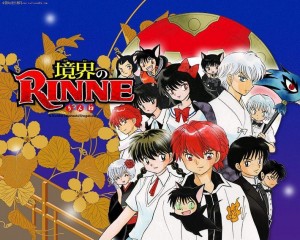
- Episodes : 10 (confirmed up to 25)
- Genre : Action, Adventure, Comedy, Supernatural
- Airing Date : April 2015 – Presently Airing
- Producers : NHK, Brian’s Base
Kyoukai no Rinne Preview / Plot (No Spoilers)
Mamiya Sakura is just an average anime high school schoolgirl (then again what is average in anime?), but she has a very distinct ability, she sees dead people. Just like the child from The Sixth Sense, no one else shares her power until she meets her newest classmate, Rokudou Rinne. Like Sakura, Rinne can also see ghosts but his role as a shinigami (a job he must do for his paternal grandmother) is to help lost spirits be reincarnated into the next life or they will become evil spirits.
In order to carry out his duties, Rinne needs his haori, or a kimono top, to give him super powers ranging from flying and making himself invisible to regular humans (except for Sakura). But when turned inside out on a ghost, it makes that ghost visible to regular humans. Rinne also uses special tools in neutralizing potential threats but they always come at a price range between 500 to 1000 yen (ranging from less than five to ten dollars under Abenomics).
However, Rinne is dirt poor and he uses a small shrine at his school for students (who may have issues with the supernatural) to give offerings in order to put food on the table (or the tatami) and make some dough. Together, Sakura and Rinne try to keep the world between the living and the dead in balance and do whatever possible to not needlessly waste money.
Who does Kyoukai no Rinne cater to?
If you're into anime that deals with not only the super natural, but also has humor, action and teen romance, then this is the series for you. This may be for people who enjoy other titles of this nature such as Bleach, Natsume Yuujinchou, Ghost Sweeper Mikami, Mononoke, and Yuu Yuu Hakusho.
If you also love Takahashi Rumiko’s previous works such as Inuyasha, Ranma ½, Maison Ikkoku and Urusei Yatsura, then this is a series that lives up to her reputation.
What's so appealing about this piece of work.
It retains Takahashi’s sense of humor but is taken with a new fresh sense of creativity. Audiences will find the series to be very educational in context to Japanese superstitions and reincarnation concepts from Buddhism.
Kyoukai no Rinne Trailer
Kyoukai no Rinne Main Characters List
Mamiya Sakura
Voice Actor :Inoue Marina
The co-lead in this series, due to an incident from her childhood, she has the ability to see ghosts. In a lot of ways it never really bothered her as she still found some way to live a normal life. Her life goes from a controlled sense of normal, to out of control when she meets her newest classmate, Rokudou Rinne, a Shinigami. Due to her abilities and a brief connection with Rinne’s family, she finds herself a part of his adventures and does what she can on her part to help out, mostly lending a small amount of change for Rinne to use certain weapons.
Rokudou Rinne
Voice Actor :Ishikawa Kaito
A teenage shinigami who just happens to be in major debt, he does his best to fulfill his family’s legacy. Rinne means the cycle of reincarnation while Rokudou means six paths, in reference to the six paths of reincarnation from Buddhism. Due to the passing of his grandfather, who raised him and refusing to live with his grandmother, he has no money and is in debt.
Under this unfortunate situation, he attends school wearing only his junior high school PE uniform because he cannot afford the school’s uniform. In order to compensate with no income, he uses an abandoned building at the school to reside in, and uses the school’s mini-shrine as a means to receive offerings (food and money) in exchange for a person’s supernatural problem he can probably help with.
Jumonji Tsubasa
Voice Actor :Kimura Ryohei
Like Sakura and Rinne, Tsubasa can see ghosts but for a different reason. It is because he comes from a family of exorcists. He briefly knew Sakura back in elementary school but had to move due to the nature of his family’s business. Since their separation, up until their reunion in high school, continues to harbor feelings for her. He is also a foil to Rinne, coming from a rich family and always dresses in sharp suits.
Contains Spoilers
Kyoukai no Rinne Review
Just like Ranma ½, the series (at this point with 10 episodes) has been episodic and/or two-partners with its approach. While Inuyasha, the previous Takahashi series, told a more central story with fighting Naraku and rebuilding the Shikon no Tama. The pace is excellently balanced with introducing its main cast and presenting its unique world.
Granted Takahashi’s previous works have been known for her gag humor, with Kyoukai no Rinne, the humor is more reliant on deadpan and irony, but still has some reoccurring gimmicks. I feel with some of the jokes, you need direct Japanese language and cultural knowledge to really understand and appreciate it. One example is Masato, one of the first main antagonists. A lot of the humor with him relies on the notion that he can’t properly write kanji, Chinese characters. Granted the subtitles do effectively explain this aspect of the character, but I feel it is more effectively funny (at least to non-Japanese audiences) if you can read and write first hand thus, realizing the mistake yourselves.
With one of his malicious pranks with his ATM card, his pin number is 4444. It's funny in a cultural sense because the number 4 is considered an unlucky number in Japan because it is read as “shi,” which also means death (though of course there are separate kanjis). This joke is more subliminal so the series (nor any subtitles I know of) doesn't directly address this aspect, so you have to be a native Japanese or have extensive knowledge to understand why that use of such a pin number is funny.
What makes this series more distinct in comparison to Takahashi’s previous works is that the relationship between Sakura and Rinne so far isn't as tense as the relationship between Ranma and Akane from Ranma ½. They easily become good friends and will never hesitate to help each other. Sakura will show some disapproval of Rinne’s methods on how he feeds and shelters himself, but she doesn't really do anything to discourage him, so she is exhibiting some sympathy over his financial situation.
However, a big aspect from previous Takahashi titles that continue to transition from one to the next, is the crazy love triangles. In this series, we have Jumonji Tsubasa who comes between Rinne and Sakura. Like the two co-leads, he is another teen with the ability to see the dead, but with his job being an exorcist, he eliminates them permanently as opposed to helping them prepare for their new life. He is very open with his feelings for Sakura, but she is not really direct in accepting or rejecting them in hopes of still maintaining their friendship.
The rivalry between Rinne and Tsubasa isn't that intense and antagonistic. They are willing to help each other when it counts, and Tsubasa sees the positives in Rinne’s methods as a Shinigami and Rinne wants Tsubasa to see that the lost spirits are worth saving.
The character design is very much in line with Takahashi’s style, the pupils and iris are wide and thin, and the faces are wide and sharp. At the same time, I don't feel the designs of the characters are at all a direct repeat/recycle of characters from her other titles. Sakura’s uniform is more in tune with Japan’s modern day school uniform with the blazer style as opposed to the sailor style from the 1990s. Rinne’s haori’s color scheme blends very well in context to the general color palette of the anime in which citrus colors are always in use with the sun setting sky which seems to be frequently used in this series a lot.
The super natural creatures are very in tune with Japanese tradition but appropriately given a more silly twist. The Damishigamis are the somewhat central enemies of Rinne and Sakura. They are essentially Shinigamis but they deceive living people into death in order to make their quotas. Generally, they are speechless stuffed animal-like creatures, but there are others that look no different from humans and other regular Shinigamis.
The voice acting works excellently well for its atmosphere as a whole (with comedy, action and romance). Inoue Marina (who you may know as Yoko from Gurren Lagaan and Armin from Attack on Titan) as the voice of Sakura is very excellent in portraying with her initial indifferences to her abilities in seeing ghosts. She may always be calm but she also knows when to give the right reactions when things go crazy. Due to Sakura not being as rough as Akane and Kagome and not as playful as Lum, I say she is a very balanced character and her performance perfectly captures her qualities.
As for Ishikawa Kaito, the voice of Rinne, my only prior exposure to him was the iconic role of Seiya in the CG Saint Seiya movie, Legend of Sanctuary. As Seiya, he has to be hot blooded and masculine. As Rinne, he is very calm and tries to compose himself as mature despite his cheapskate nature, which offers a lot of deadpan delivery. When it comes to being offered food, I love how he always tries to contain his feelings and excitement when in fact, he wants to jump for joy.
I feel the performances of these seiyuus bring excellent chemistry to these two characters. You can feel that they are purely friends, though they can blossom to something more. One addition that surprised me is Kakihara Tetsuya, as Masato. You may know him as Tenma from Saint Seiya Lost Canvas and Simon from Gurren Lagaan.
Due to the nature of the character, he tries to come across as scary but incidentally comedic due to being illiterate and childish, despite his wealth. And two more alumni from Inuyasha are in this series. One is Yukino Satsuki, the voice of Kagome, playing the role of Tamako, while with one more voice actor, please read the events to find out.
I think the weakest point of this anime is the music. The background music doesn’t really stand out, but I feel the quality of the acting and the animation does enough to make the viewer interested in what’s going on, so maybe music in that sense is not a high priority for this anime. The opening and ending themes are songs that have been done before with messages of teenage romance and living as a free spirit. The quality of the vocals in both songs is nothing distinctive in terms of J-pop as a whole and is way too trendy. With the opening song, Oukaranman by KEYTALK, what I call the loud nasal singing voice, is about as lame as western rock singers trying to copy Eddie Vedder’s deep drawl.
I still give it credit in being in appropriate tone with the series, and I think the animation goes very well with the rhythm and instrumental. I am personally disappointed in the music because previous Takahashi based anime series always have delivered excellent soundtracks with Inuyasha (by having big name J-pop artists like Hamasaki Ayumi and K-pop queen BoA, contributing some great songs), Ranma (through Coco, the 1980s and 1990s J-pop idol group), and Maison Ikkoku (which paved way for Saitou Yuki, who is now an entertainment legend).
1. Rinne’s Grandparents
What the audience knows about Rinne’s upbringing is that his grandparents raised him. His grandmother, Tamako, being a Shinigami, is sent to claim the soul of a dying human man but instead falls in love with him and extends his life for another 50 years. As a stipulation for her actions and marriage, if she cannot meet her extended quota of helping souls, her descendants must take the role as a Shinigami and work until that quota is fulfilled.
2. Why Sakura Sees Dead People
It turns out when Sakura was on vacation as a little girl, she was spirited away by a Damashigami. In the world she was taken to, it has a traditional Japanese festival setting. She has fun there like any child would and tried some of the food. Due to the food being of supernatural nature, upon her return to the world of the living thanks to Tamako, Rinne’s grandmother who saw through the scheme, she incidentally gains the sixth sense.
3. Rokudou Sabato
Though the audience is consistently made aware of Rinne being raised by his grandfather, we still know nothing about his parents until episode 10. It turns out the main reason why Rinne is in debt is because of his own father, Rokudou Sabato. He is the president of the Damashigami Company, but despite his role, he bums off his girlfriends and his own son! In his own twisted way, he still cares for Rinne and actually wants him to take his place. Rinne wants nothing to do with his father, and even his own grandmother indicates to have disowned him. Even though dysfunctional family relationships have always been a large part of Takahashi’s works, this is taken to a whole new extreme.
The most interesting thing to note about Sabato is that his seiyuu is Yamaguchi Kappei, who previously played Ranma and Inuyasha. While he used a very aggressive voice and very rude Japanese in those roles, as Sabato, he is very calm and his voice feels more casual and “handsome” that you can’t recognize it. It is also very different from the more dark and cutesy tone he used as L in DeathNote. He’s all about living life at the expense of others, mostly his son.
Kyoukai no Rinne Season Conclusion
With this initial installment at its end, it is pleasing to see that dedicated fans will get more episodes in 2016. As for this first season, it excellently provides viewers who the characters are as individuals, and their wacky relationships with each other. Sakura as a co-lead in comparison to other Takahashi female leads is rather new. It is interesting how she easily goes along with things and never once panics. Either she is a stable person comfortable with who she is, or is a good representation of Japan’s “shikata ta nai” mentality whenever something bad happens (think of it as a Japanese way of saying $#*+ happens).
By the end of this series, you see how the relationships, most especially between Rinne and Sakura grows to the point that one cannot exist without the other. Compared to the relationships between Ranma and Akane from Ranma ½ and Inuyasha and Kagome from Inuyasha, their relationship feels like a breath of fresh air. Though it is easy to conclude they don't hook up as lovers upon the end of season one, but once you see this series, you do see they still share something that is beyond special.
The series is mostly episodic in nature with a few loose two-partners so you can get into this series by catching virtually any episode. Most of the episodes offers the same formula but always with a different twist to keep it from getting repetitive. Due to this structure, the story is very easy to follow and it promises to deliver laughs and something educational.
If any of you readers have no familiarity with Takahashi Rumiko, Japan’s most legendary manga-ka, this is a series that serves as a perfect gateway! Much of Kyoukai no Rinne shares much of the same qualities as her other classics like Urusei Yatsura, Ranma ½ and Inuyasha, but so much of it is fresh. What is most unique about Kyoukai no Rinne is that is culturally Japanese at its foundation, but captures a very universal appeal.
To non-Japanese viewers, this series can be loosely educational about Japanese spirits along with the country’s concept of death and reincarnation. Maybe in the mean time some of us can get ready for the next series by either reading the manga, or be patient when the next season comes out. The only thing this series needs is a better soundtrack with some of Japan’s (or Korea’s) hottest singers which Inuyasha and Ranma offers with legends such as Namie Amuro, Ayumi Hamasaki, and BoA.
With 15 episodes left of this series based upon this present review, I look forward to seeing what happens next and where they end it. Will it have sense of closure? Or will it be open to more installments? From my understanding, the manga is presently 25 volumes so future animated installments is a very strong possibility. When this first series is over, look forward to a more in depth review as a whole. Until then, be careful of how you use your money.
Recommended Post
6 Anime Like Kyoukai no Rinne [Recommendations]
Recommended Post



